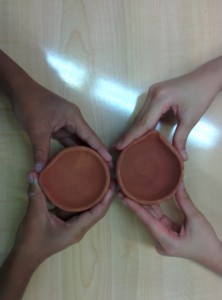Unit of Inquiry: Celebrations Express Traditions of a Culture.

Diwali Diyas for India.
International perspective: A driving force behind the PYP is the philosophy of international mindedness. The IB’s mission statement strives to nurture young people who recognize that they are global citizens and who are motivated to make changes to and in the world.
Along this idea, the new U.O.I. for Grade 1 discusses the celebrations that occur in November and December. The children are learning about: Diwali, Christmas, Ramadan, Hanukkah, Kwanzaa and Posada.
Teacher Questions: What is a culture? What is a tradition? What are some important holidays that people celebrate in November and December? Why do people celebrate? What are some similarities among celebrations? What are some differences between celebrations?
Lines of Inquiry: The characteristics of a culture. The reasons people celebrate. Similarities and differences between celebrations around the world.

IB Learner Profile : Open Minded
‘They understand and appreciate their own cultures and personal histories, and are open to the perspectives, values and traditions of other individuals and communities. They are accustomed to seeking and evaluating a range of points of view, and are willing to grow from the experience.’ (IBO, 2010)
Assessing Prior Knowledge: Students collaborated in groups and began the unit by brainstorming about a celebration they were familiar with. They had a lot of questions at the beginning of the unit: How were celebrations made? Why is Christmas a celebration? Why do people like or don’t like celebrations? Why do we eat special food for celebrations?
 These questions are valid for both children and adults. Often, the meaning behind celebrations are unknown or we forget their significance. I was impressed when the students were able to share with me their knowledge for these particular celebrations. They were engaged and interested in the ceremonies, traditions, stories, origin of celebration, and special foods or items.
These questions are valid for both children and adults. Often, the meaning behind celebrations are unknown or we forget their significance. I was impressed when the students were able to share with me their knowledge for these particular celebrations. They were engaged and interested in the ceremonies, traditions, stories, origin of celebration, and special foods or items.